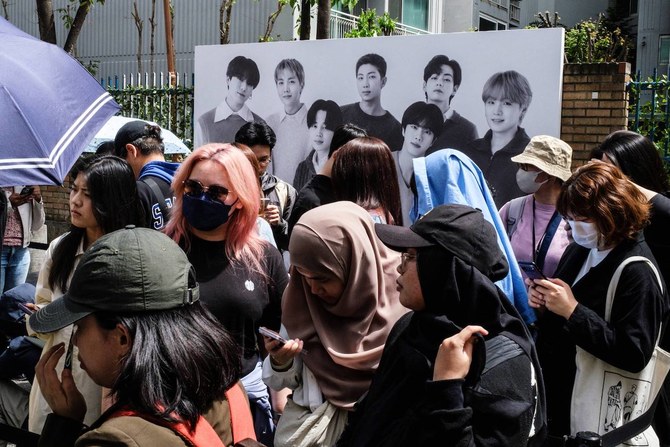JAKARTA: Fans of the world’s biggest K-pop band, BTS, are demanding the group’s record label divest from entities linked to Israel, harnessing the fandom’s prowess for social justice activism to support Palestine.
BTS, also known as the Bangtan Sonyeondan, or “Bulletproof Boy Scouts,” is the seven-member K-pop group that has become one of the music industry’s most profitable franchises since its 2013 debut. The millions of BTS fans around the world are collectively known as ARMY.
The enormous fandom has gained its own popularity over the years, becoming known for its online activism and making global headlines as members raise millions of dollars for charity and organize viral social media campaigns.
Some of those fans are now part of a group called ARMY for Palestine and have been coordinating efforts directed at the band’s label, Hybe Corporation, urging the company to sever ties with Scooter Braun, the CEO of the label’s American subsidiary, for his support for Israel.
“We have our ongoing Hybe divestment campaign, where we demand that Hybe divest from Zionist companies and collaborators, including Hybe America CEO Scooter Braun,” Lila, a Palestinian member of the group, told Arab News.
On X, Lila and her friends have promoted the #HybeDivestFromZionism campaign, which not only calls for Braun’s dismissal, but also urges fans to stop buying albums and merchandise, and streaming music from artists signed to the label.
ARMY for Palestine took its campaign to the streets of Seoul in March, when members sent an electronic billboard truck outlining their demands to Hybe headquarters in the South Korean capital.
“As an ARMY it’s important because this is exactly what we have always claimed this fandom stands for … ARMY is known to be very involved in fandom activism,” Lila said.
“We were hoping to put that empathy, advocacy, loudness, progressivity and organizing skill that we have been known for over the past decade to good use … there are so many Palestinian ARMYs.
“We have lost so many members of this community to the brutal war crimes of the occupation. So many ARMYs are in Gaza, experiencing a genocide.”
Israel’s ground and air attacks over the past nine months have killed more than 39,000 Palestinian citizens in Gaza, according to official estimates, though a study published in the Lancet journal last month estimated that the actual death toll could exceed 186,000.
Some BTS fans began speaking up about Israel’s war on Gaza in November last year, when a clip showing photographs of the band members being pulled from rubble in the enclave went viral online. ARMY for Palestine was launched around the same time.
The group is run by Palestinian members of the BTS fandom — some of whom are based in the US and Europe — and people from other countries including India, Pakistan and Malaysia.
Deeja, another Palestinian member of the group, said that being an ARMY member means reflecting “the values of BTS in being socially aware” and caring about other people.
“It’s important to us that ARMY see our humanity as Palestinians, though, so we think that’s why being in this space as both Palestinian and ARMY is so important to us — to really be ourselves as an advocate for our people in this space,” she told Arab News.
“Honestly, we just want people to care — to care about Palestinians and to see Palestinians … start listening to Palestinians and our voices. The most essential tool to keep fighting oppression is community. Anything is possible if you have a community of like-minded people behind you.”
Though ARMY for Palestine is encouraged by the support it has received from the international community, its members have also suffered “backlash and harassment” from within the BTS fandom since last year.
“There is a division … it’s definitely something that’s been disheartening — and pretty terrifying to see people who were in community with us dehumanize us just because we are Palestinians asking for people to help us,” group member Zuzu told Arab News.
“Despite the pushback, we have still built a little, beautiful community with empathetic, caring ARMYs who are willing to organize, use their voice for oppressed people and push for change. Our movement keeps growing … we’ll continue being loud.”
For Casey, an Indonesian ARMY member based in Bogor, West Java, speaking up for Palestine is part of what it means to be a BTS fan, even though members of the K-pop group themselves have yet to speak up about the violence in Gaza.
“BTS is the biggest K-pop idol group and ARMY is the biggest fandom. The voices of idols and their fans can be influential,” Casey told Arab News.
“BTS and ARMY voices are very much needed to educate and raise awareness on the genocide that is happening in Palestine.”
























